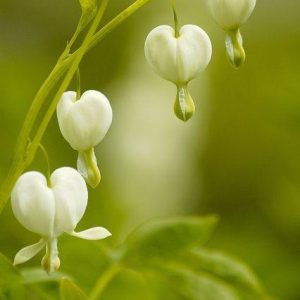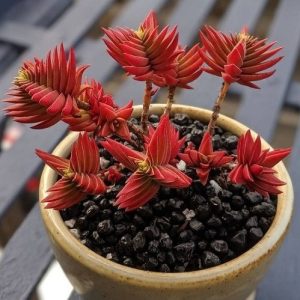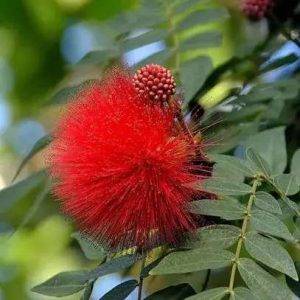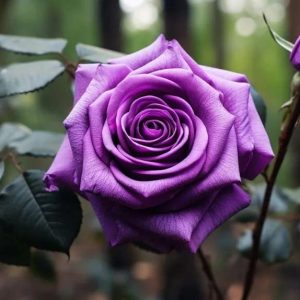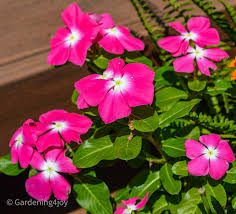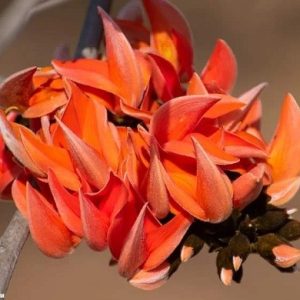Michigan’s short, sweet season is surprisingly ideal for growing perennial flowers. The last frost usually occurs in late May to early June, and the first frost typically happens in September or October. That gives Michigan gardeners roughly 100 days to plant, grow, and enjoy their gardens. Fortunately, its brevity makes beautiful blooms all that much more enjoyable.
To flower again next year, most perennial plants need a period of dormancy during which they can rest and recharge. The extreme winter temperatures in Michigan fulfill this need. Hardiness varies from zone 4 in parts of the upper peninsula to zone 6 in coastal regions. The average minimum temperature can fall between -30 and -5°F, so your perennials will have plenty of time to chill out.
Plant dormancy is triggered by shorter days, diminished sun intensity, and dropping temperatures. This signals to perennial plants that it’s time to harden off, conserve moisture, and shut down. Stems and foliage above ground will appear dead, but the underground roots are alive and well.
Since Michigan is surrounded almost entirely by water, it typically has a fairly high level of annual precipitation, which helps many plants thrive. While hundreds of perennials will grow well in Michigan gardens, we’ve profiled 21 of our favorites below. Read on for detailed information about each plant’s growing requirements, bloom times, and unique characteristics.

botanical name Asclepias tuberosa |
|
bloom colors Orange, yellow |
|
sun requirements Full sun |
|
height 1-2 feet tall and wide |
|
hardiness zones 3-9 |
Butterfly weed is prized for its extra-long bloom time and ability to draw beneficial insects to the garden. It is in the milkweed family and can be found in Michigan’s wild and cultivated landscapes.
Because it spreads by seed rather than underground stolons, butterfly weed is easier to manage than some of its common milkweed cousins, but you will still want to stay on top of it. Diligent deadheading is the key to preventing seeds from distributing randomly in the wind.
Butterfly weed is 1-2 feet tall and has a rounded habit. Its stems are very sturdy, and its glossy green leaves are lance-shaped. While butterfly weed will need supplemental watering during its first season, you won’t have to give it much thought in subsequent summers. It prefers dry soil and extreme amounts of sunshine, making it a perfect perennial flower for dryer Michigan gardens.
Varieties to try: ‘Hello Yellow,’ ‘Western Gold Mix,’ and ‘Gay Butterflies’

botanical name Achillea millefolium |
|
bloom colors Orange, yellow, white, red, purple |
|
sun requirements Full sun |
|
height 2-3 feet tall and wide |
|
hardiness zones 3-9 |
Native to Europe, Asia, and North America, this drought-tolerant perennial has a bushy, compact habit and produces an abundance of multi-branched corymbs in shades of white, yellow, orange, red, and purple. The plant’s leaves are feather-shaped and have a spicy scent.
Yarrow loves full sun and thrives in temperatures between 65 and 85 degrees, which makes it perfect for Michigan summers. It grows well from seed, but you may want to get a jump start on the season by sowing indoors sometime in mid-April. To prevent unwanted spread, deadhead often and cut plants down to the ground in late fall.
Varieties to try: ‘Achillea,’ ‘Gold Plate,’ and ‘New Vintage Rose’

botanical name Hosta spp. |
|
bloom colors White, purple, pink |
|
sun requirements Partial to full shade |
|
height 1-4 feet tall, 1-5 feet wide |
|
hardiness zones 3-9 |
Although we think of hosta as a vegetative plant rather than a flowering perennial, hostas do send up blooms each season. And some are quite lovely. Most arrive in mid-summer on stalks that extend above the mounded foliage, which can vary in color from lime to forest green to silvery blue.
With so many trees and forested regions in Michigan, hostas are a go-to for settings with part or full shade.
Although the flowers are relatively small, they bring some much-valued color to woodland landscapes. Hostas multiply quickly and provide great depth of color and texture. Divide them every few years and redistribute.
Varieties to try: ‘Blue Mouse Ears,’ ‘White Christmas,’ and ‘Guacamole’

botanical name Phlox subulata |
|
bloom colors White, purple, pink |
|
sun requirements Full sun to partial shade |
|
height 6-12 inches tall, 12-24 inches wide |
|
hardiness zones 3-9 |
This lovely little gem acts as a flowering ground cover in spring, blanketing the soil with tiny, fragrant blooms. Members of the subulata group are particularly popular perennial flowers in Michigan. They can be found beneath shrubs and trees or in rock gardens and border plantings.
Creeping phlox foliage is also interesting, resembling fern or rosemary leaves and sprawling twice as wide as tall. Its coloring can vary from bright green to deep sage. Shear back blooms after they’ve faded, and the flowers will repeat several times into early summer.
Varieties to try: ‘Candy Stripe,’ ‘Fort Hill,’ and ‘Scarlet Flame’

botanical name Papaver orientale |
|
bloom colors Orange, red, white, purple, pink |
|
sun requirements Full sun to partial shade |
|
height 1-3 feet tall, 1-2 feet wide |
|
hardiness zones 3-8 |
This cold-hardy favorite dislikes extreme heat and humidity, which makes this flowering perennial a winner for Michigan gardeners. Poppy flowers are big and boldly colored. They have layered petals with crepe paper texture and a dark ‘eye’ at their centers. Its foliage is also interesting, with thick hairy stems and large, coarse leaves often mistaken for thistle.
Plant poppies where another perennial or shrub will grow up around it by late summer, as this is when foliage will fade and collapse. Poppies make a lovely cut flower, and the seed pods that form after blooming are often used in dried arrangements.
Varieties to try: ‘Bolero,’ ‘Fireball,’ and ‘Harlem’

botanical name Solidago spp. |
|
bloom colors Yellow |
|
sun requirements Full sun to partial shade |
|
height 1-5 feet tall, 1-3 feet wide |
|
hardiness zones 2-8 |
Goldenrod species bloom all at once in the late summer landscape. They feature tall racemes of fluffy yellow flowers that are particularly beneficial to pollinators. Often confused with ragweed, which blooms at a similar time, goldenrod is not an allergy trigger. It is also not on the invasive species list, although managing its spread should be a part of your maintenance practices.
Leaves and stems have no real interest before and after bloom time, so plant goldenrod with other prairie-style perennials for a season-long display of color. An established plant is not picky about soil makeup and can tolerate drought, but goldenrod must be located in full sun to flower. Remove spent flowerheads promptly to discourage seed spread, and cut plants down to the ground at the end of the season.
Varieties to try: ‘Fireworks,’ ‘Golden Fleece,’ and ‘Canada Goldenrod’

botanical name Penstemon spp. |
|
bloom colors Purple, pink, red, white |
|
sun requirements Full sun |
|
height 1-6 feet tall, 1-2 feet wide |
|
hardiness zones 3-9 |
Featuring tall stalks of tubular flowers that are highly attractive to hummingbirds and bees, this is one of the most popular flowering perennials in Michigan. Its lovely flowers have extra long stamens that droop from their throats like a tongue, and that’s how this genus earned its common name.
Since the leaves and stems are not exceptional, plant beardtongue in the rear or middle border and front them with shorter, fuller perennials. As native prairie plants, beardtongue prefers sandy, loamy soil to rich, moist locations. Check plant tags before purchasing to ensure a variety is hardy down to zone 4, as some species might not grow well in the upper peninsula.
Varieties to try: ‘Apple Blossom,’ ‘George Home,’ and ‘Rich Ruby’

botanical name Veronica officinalis |
|
bloom colors White, purple, pink, blue |
|
sun requirements Full sun to partial shade |
|
height 1-4 feet tall, 1-2 feet wide |
|
hardiness zones 3-9 |
Veronica flowers grow on spiky racemes from finely cut, sage green base foliage. Prized for its extra-long bloom time, members of this genus will keep flowering for most of the summer if they are deadheaded regularly. Sizes range from very small at less than a foot to extremely tall at 4 feet. The stems are thin and somewhat fragile, so heavy racemes should be staked.
Veronica is drought, pest, and disease-resistant but attractive to butterflies. As a bonus, the scent turns deer away, and they will not graze on it. Plant Veronica in front or middle border locations, and reserve a few plants for cutting, as they last a long time in the vase.
Varieties to try: ‘Patty’s Purple,’ ‘Aspire,’ and ‘Blue Bomb’

botanical name Echinacea purpurea |
|
bloom colors Purple, pink |
|
sun requirements Partial to full shade |
|
height 3-4 feet tall, 1-2 feet wide |
|
hardiness zones 3-8 |
Popular in the Midwest for its cold tolerance and pollinator benefits, purple coneflower features 5-6 inch flowers that keep coming for weeks in late summer. Coneflower’s petals are fanned out in a single ray shape around a prominent central seed cone highly attractive to bees and butterflies. Its leaves are coarse and lance-shaped, adding textural interest even when this plant is not blooming.
Purple coneflower is a long-lived perennial that can return for decades if properly cared for. Dig it up every few years, divide it into chunks, and replant it to prevent crowded roots and diminished flower quality.
Varieties to try: ‘Pink Poodle,’ ‘Ruby Star,’ and ‘Vanilla Cupcake’

botanical name Asclepias syriaca |
|
bloom colors Pink, mauve, white |
|
sun requirements Partial to full shade |
|
height 2-4 feet tall, 1-2 feet wide |
|
hardiness zones 3-9 |
One of the most important plants to include in your Michigan pollinator garden, milkweed is a major food source and shelter for the endangered monarch butterfly. It serves as a host plant to the insect’s larvae, which feast on milkweed’s broad, coarse leaves in their early stages of development.
Milkweed flowers are rounded in a compact umbel shape and strongly scented. Typically a rosy pink color, the blooms are also white on some cultivars.
Its leaves have a milky substance that oozes when torn or broken off. A native that spreads liberally, milkweed can grow out of control and become invasive if you don’t remove seed pods before they open. Only plant this perennial if you’re committed to keeping it in check.
Varieties to try: ‘Green,’ ‘Whorled,’ and ‘Rushed’

botanical name Rudbeckia hirta |
|
bloom colors Yellow, orange, red |
|
sun requirements Full sun |
|
height 1-3 feet tall, 1-2 feet wide |
|
hardiness zones 3-9 |
One of the staple perennial flowers in Michigan, this cheerful plant can be found in ornamental gardens and wild meadows along the highway. Rudbeckia flowers are daisylike, with a single ray fanning out around a brown central disk. Its coloring is typically orange or yellow, but there are also some red varieties.
Leaves are broad and dark green, with a fuzzy texture that repels insects. Spent flowers should be removed promptly if seed spread is a concern, but this genus spreads mostly by clumped roots. Divide every few years to keep black-eyed Susan full of flowers and free from powdery mildew.
Varieties to try: ‘Summerina Orange,’ ‘Golstrurm,’ and ‘Autumn Colors’

botanical name Amsonia |
|
bloom colors White, purple, blue |
|
sun requirements Full sun to partial shade |
|
height 2-3 feet tall and wide |
|
hardiness zones 3-11 |
Loose clusters of small, star-shaped flowers sit atop a willowy base on this delicate spring bloomer. bluestar (Amsonia) petals are thin and delicate in shades of blue, white, and purple. Its leaves are 3-4 inches long and lance-shaped, fanning outward from multi-branched stems to create an attractive backdrop for other perennials. As a bonus, they turn golden yellow in the fall.
Amsonia looks at home in woodland and cottage gardens but also grows well in a container. Plant alongside annuals and perennials with yellow flowers for a complementary color palette. While the genus is considered low-maintenance, Amsonia does require relatively moist soil and will fare better with some light afternoon shade.
Varieties to try: ‘Blue Star,’ ‘Blue Ice,’ and ‘Short Stack’

botanical name Dianthus spp. |
|
bloom colors Pink, purple, white, red |
|
sun requirements Partial to full shade |
|
height 6-24 inches tall and wide |
|
hardiness zones 3-9 |
This is a common perennial flower in Michigan. It can be found in front borders and under trees and shrubs throughout the state. With a relatively short stature and wide-spreading habit, dianthus is often used as a ground cover in the ornamental landscape. Flowers are small and single or semi-double in form, with sheared or fringy petal margins.
The foliage is mounded and varies in color from sage green to chartreuse. It is finely textured and pinnate, resembling rosemary leaves or blades of grass. Dianthus has a spicy scent and flower nectar that is attractive to pollinators. Cut back after flowering and will come again several times early in the growing season.
Varieties to try: ‘Coconut Punch,’ ‘Fire Star,’ and ‘First Love’

botanical name Perovskia atriplicifolia |
|
bloom colors Purple, blue |
|
sun requirements Full sun |
|
height 2-3 feet tall and wide |
|
hardiness zones 4-9 |
With a shrubby habit and an explosion of purple-blue color in early summer, Russian sage is a favorite perennial flower in Michigan. Its flowers open slowly on tall spikes, emerging a silvery blue before turning a rich, dark purple. The foliage is thin, finely cut, and lightly scented with a blue-gray coloring that provides great contrast behind other flowering perennials.
Since flowers will be present on only the upper half of the plant body, use Russian sage in the rear or middle border with something short and colorful covering its leggy undergrowth.
Although stems will be woody and substantial at the end of the season, this perennial blooms on new growth and should be cut down completely before spring. Cover the ground above it with a thick layer of mulch in winter, particularly in north central Michigan and the U.P.
Varieties to try: ‘Little Spire,’ ‘Blue Jean Baby,’ and ‘Crazy Blue’

botanical name Lupinus spp. |
|
bloom colors White, purple, pink, red, yellow |
|
sun requirements Full sun |
|
height 3-4 feet tall, 1-2 feet wide |
|
hardiness zones 4-8 |
Large, dramatic spikes of color can be enjoyed everywhere lupine is planted. Flowers are vertical and bottle-shaped, ranging from 2 to 8 inches. They are complex and raceme-form, with many smaller blooms along an axis. The leaves are thick, waxy, and palm-like, creating a substantial foundation for lupine flowers.
Although stems are strong, flower heads are very heavy and prone to breakage in high winds or heavy rains. Larger varieties should be staked for stability. A must-have addition to the cutting garden, lupines bloom from the bottom up and should be cut as soon as the lower petals begin opening.
Varieties to try: ‘Grape Taffy,’ ‘Lemon Meringue,’ and ‘Lunar Eclipse’

botanical name Eutrochium spp. |
|
bloom colors Pink, purple |
|
sun requirements Full sun to partial shade |
|
height 5-7 feet tall, 2-4 feet wide |
|
hardiness zones 3-9 |
If you’ve got the space for this stately prairie plant in your landscape, you’ll want to work some Joe Pye weed into the mix. Soaring to heights of up to 7 feet and flowering for an extra long time late in the season, this perennial features rosy pink compound umbels that are highly attractive to butterflies and bees. Its blooms give off a sweet vanilla odor that’s very pleasant.
Joe Pye weed requires at least 6 hours of full sun to flower, but it may wilt in strong afternoon heat and should be sited with this in mind. Roots should be kept evenly moist but not soggy. At the end of the season, cut stalks completely down to the ground, and this one will return for many years.
Varieties to try: ‘Coastal Plain,’ ‘Sweet Scented,’ and ‘Baby Joe’

botanical name Digitalis purpurea |
|
bloom colors Purple, pink, red, white |
|
sun requirements Full sun to partial shade |
|
height 2-6 feet tall, 1-2 feet wide |
|
hardiness zones 4-10 |
Although it takes a year to establish, it will return for countless seasons afterward. Foxglove is a dramatic cottage garden darling worth all the fuss. On stalks that range from 2-6 feet in height, a dense cluster of down-drooping, bell-shaped flowers rises from a sturdy green base. The blooms come in shades of purple, pink, red, and white, and most have white-speckled throats.
A natural along fences or in rear borders, foxglove requires full sun and pairs well with other cottage charmers like roses and peonies. Keep in mind that they are toxic to both humans and pets. Locate them where they will not pose a risk.
Varieties to try: ‘Camelot White,’ ‘Sunset,’ and ‘Candy Mountain’

botanical name Astilbe spp. |
|
bloom colors Purple, pink, red, white |
|
sun requirements Partial to full shade |
|
height 1-3 feet tall and wide |
|
hardiness zones 3-9 |
With a lush landscape full of mature trees, gardeners often look for perennial Michigan flowers that will bring some color to shady spots. Astilbe is one of the top performers in that category. It features tall spikes of feathery plumes in shades of pink, purple, white, and red. Astilbe comes in sizes ranging from petite to large and blooms for a long time in mid-summer.
Astilbe has light fern-like foliage that provides much-needed texture and mass in woodland areas when not in bloom. It will also grow well between tree roots, around rocks, and on uneven ground. Keep roots moist but not soggy, and space them for good airflow to prevent powdery mildew.
Varieties to try: ‘Amethyst,’ ‘Deft Lace,’ and ‘Fanal’

botanical name Allium spp. |
|
bloom colors Purple, pink, white, blue |
|
sun requirements Full sun |
|
height 1-4 feet tall, 3-12 inches wide |
|
hardiness zones 3-9 |
Casually known as ornamental onion, allium plants pack a nice punch in the garden at a time when most Michigan landscapes are experiencing a lull. During the period between spring bulbs and summer stars, this bulbous perennial sends up perfectly round clusters of little flowers ranging from 2 to 10 inches across.
Resembling fireworks and retaining their color for several weeks, allium flowers sit atop long, slender, tubular stems that resemble chives. After flowering, heads can be cut down to the ground or left in place for visual interest and wildlife nourishment. Allium’s tall stature and unique bloom shape make it a go-to for both live and dried flower arrangements.
Varieties to try: ‘Gladiator,’ ‘His Excellency,’ and ‘Mount Blanc’

botanical name Helenium autumnale |
|
bloom colors Yellow, orange, red |
|
sun requirements Full sun |
|
height 2-5 feet tall, 1-2 feet wide |
|
hardiness zones 3-8 |
Commonly called ‘sneezeweed,’ this cheerful perennial is not actually a significant allergy trigger. The name refers to an ancient medicinal snuff made from its flower parts. Helenium blooms appear in late summer on multi-branched stems. Flowers are single-form and ray-shaped, resembling marigolds or sunflowers in character.
Helenium plants look at home in the prairie or cottage garden and pair well with other late-season perennials like purple coneflower and asters. Use in the middle or rear border of a bed that gets adequate moisture, as they are native to North American wetlands.
Varieties to try: ‘Zimbelstern,’ ‘Potter’s Wheel,’ and ‘Mardi Gras’

botanical name Mertensia virginica |
|
bloom colors Blue |
|
sun requirements Partial to full shade |
|
height 2 feet tall and wide |
|
hardiness zones 3-8 |
Native to the woodlands of eastern North America, Virginia bluebells enjoy cool, shady, and moist sites. This makes them a popular perennial flower in Michigan because they complement the tree-covered landscape. Blooming in late spring after the tulips and daffodils have finished showing off, bluebells are another shade lover that can deliver color en masse.
A rich burgundy hue when they emerge from the earth in early spring, leaves turn chartreuse green as they mature. Soon, 2-foot flower stems will erupt with clusters of small but showy, bell-shaped blooms that will fill the yard with a light, sweet fragrance.
It’s important to note that this genus will spread by both seed and rhizomes. Plant it where it has room to roam and be prepared for some maintenance.
Varieties to try: ‘Excelsior,’ ‘Dainty Maid,’ and ‘Indigo Blue’
Bordered by four of the five Great Lakes, Michigan boasts the most freshwater coastline in the United States. It also features nearly 20 million acres of forested land. Add to that a broad swing in seasonal temperatures that produces a true winter and a true summer, and you’re left with a rich, fertile climate for growing plants.
Michigan’s diverse landscapes include everything from sprawling farmland to suburban backyards to urban balcony gardens. When selecting plants for a perennial flower garden, consider sun exposure and soil drainage first, and the rest will follow. Choosing some plant varieties to try is the fun part. We hope we’ve made the task a little bit easier and a lot more colorful!
